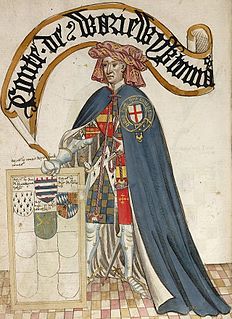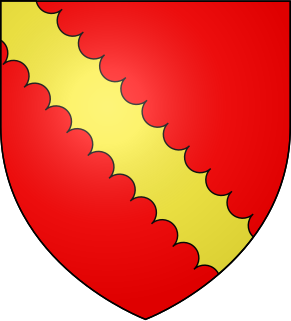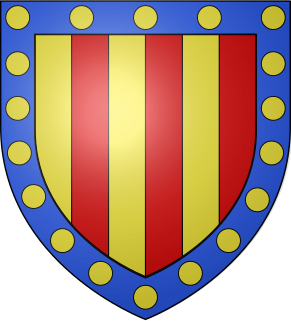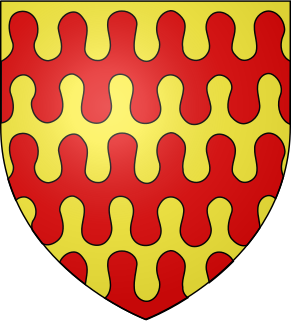
The Battle of Bannockburn on 23 and 24 June 1314 was a victory of the army of King of Scots Robert the Bruce over the army of King Edward II of England in the First War of Scottish Independence. Although it did not bring an end to the war, as victory would only be secured 14 years later, Bannockburn is still a major landmark in Scottish history.

Elizabeth de Clare, 11th Lady of Clare was the heiress to the lordships of Clare, Suffolk, in England and Usk in Wales. She was the youngest of the three daughters of Gilbert de Clare, 6th Earl of Hertford and Joan of Acre, and sister of Gilbert de Clare, who later succeeded as the 7th Earl. She is often referred to as Elizabeth de Burgh, due to her first marriage to John de Burgh. Her two successive husbands were Theobald II de Verdun and Roger d'Amory.

Thomas de Beauchamp, 11th Earl of Warwick, KG, sometimes styled as Lord Warwick, was an English nobleman and military commander during the Hundred Years' War. His reputation as a military leader was so formidable that he was nicknamed 'the devil Warwick' by the French. In 1348 he became one of the founders and the third Knight of the Order of the Garter.
Walter Stewart was the 6th Hereditary High Steward of Scotland and was the father of King Robert II of Scotland, the first Stewart monarch.
Gilbert de Clare, 8th Earl of Gloucester, 7th Earl of Hertford was an English nobleman and military commander in the Scottish Wars. In contrast to most English earls at the time, his main focus lay in the pursuit of war rather than in domestic political strife. He was the son of Gilbert de Clare, 7th Earl of Gloucester, and Joan of Acre, daughter of King Edward I. The older Gilbert died when his son was only four years old, and the younger Gilbert was invested with his earldoms at the young age of sixteen. Almost immediately, he became involved in the defence of the northern border, but later he was drawn into the struggles between Edward II and some of his barons. He was one of the Lords Ordainers who ordered the expulsion of the king's favourite Piers Gaveston in 1311. When Gaveston was killed on his return in 1312, Gloucester helped negotiate a settlement between the perpetrators and the king.
Events from the 1310s in England.

Sir Robert Keith was a Scottish knight, diplomat, and hereditary Marischal of Scotland who commanded forces loyal to Robert Bruce at the Battle of Bannockburn.

Robert Ufford, 1st Earl of Suffolk, KG was an English peer. He was created Earl of Suffolk in 1337.
Sir Philip Mowbray or Philip de Mowbray was a Scottish noble who opposed Robert the Bruce in the Wars of Scottish Independence. He later changed his allegiance to Scotland and was killed in 1318 fighting in Ireland.
Isabel de Verdun, Baroness Ferrers of Groby was an heiress, who was related to the English royal family as the eldest daughter of Elizabeth de Clare, herself a granddaughter of King Edward I of England. When she was a child, Isabel was imprisoned in Barking Abbey, along with her mother and half-sister, after her stepfather had joined the Earl of Lancaster's ill-fated rebellion against King Edward II. Her husband was Henry Ferrers, 2nd Baron Ferrers of Groby.
John Comyn IV, Lord of Badenoch was the son of John III "The Red" Comyn, former leader of Scottish rebels against the English, who was killed by Robert the Bruce in the Greyfriars church in Dumfries on 10 February 1306. He was sent to England after his father's death by his mother Jeanne de Valence.
Maud de Clare, Baroness de Welles was the eldest daughter of Thomas de Clare, Lord of Inchiquin and Youghal, Lord of Thomond, Lord of Bunratty Castle (1245–1287) and Juliana FitzGerald (1236–1290). She married twice. Her first marriage was to Robert de Clifford, 1st Baron de Clifford, 1st Lord of Skipton (1274–1314) on 3 November 1295 by which she had four children. Her second marriage was to Sir Robert de Welles, 2nd Baron Welles, Constable of Pendragon Castle (1297–1326) on 16 Nov 1315. They had no children. She was born in 1276 in Tewkesbury, Tewkesbury Hundred, Gloucestershire, England and moved to Badlesmere to be near her sister, Margaret de Clare, Baroness Badlesmere. She died in Badlesmere in 1327 twice a widow.
Sir Edmund Comyn of Kilbride was a 13th-14th century Scottish noble. He was a younger son of William Comyn of Kilbride and Euphemia de Clavering.

Richard Grey, 2nd Baron Grey of Codnor, of Codnor Castle, was an English soldier and diplomat.
Edmund Hastings, 1st Baron Hastings, Lord of Inchmahome, was an Anglo-Scottish noble. He served as Governor of Perth, Governor of Berwick, Constable of Dundee and Sheriff of Berwick. He was killed during the Battle of Bannockburn against the Scots on 23 or 24 June 1314.

William Marshal, Lord of Hingham, was an English noble. He was hereditary Earl Marshal of Ireland and was slain during the Battle of Bannockburn, Scotland in 1314.

John de Clavering, Lord of Clavering, was an English noble.

John de Montfort, was an English noble. He was slain during the Battle of Bannockburn, Scotland in 1314.

Richard Basset, 1st Baron Basset, Lord of Weldon, was an English noble.

John Lovel, 2nd Baron Lovel, Lord of Titchmarsh, was an English noble. He was killed during the Battle of Bannockburn against the Scots on 23 or 24 June 1314.











